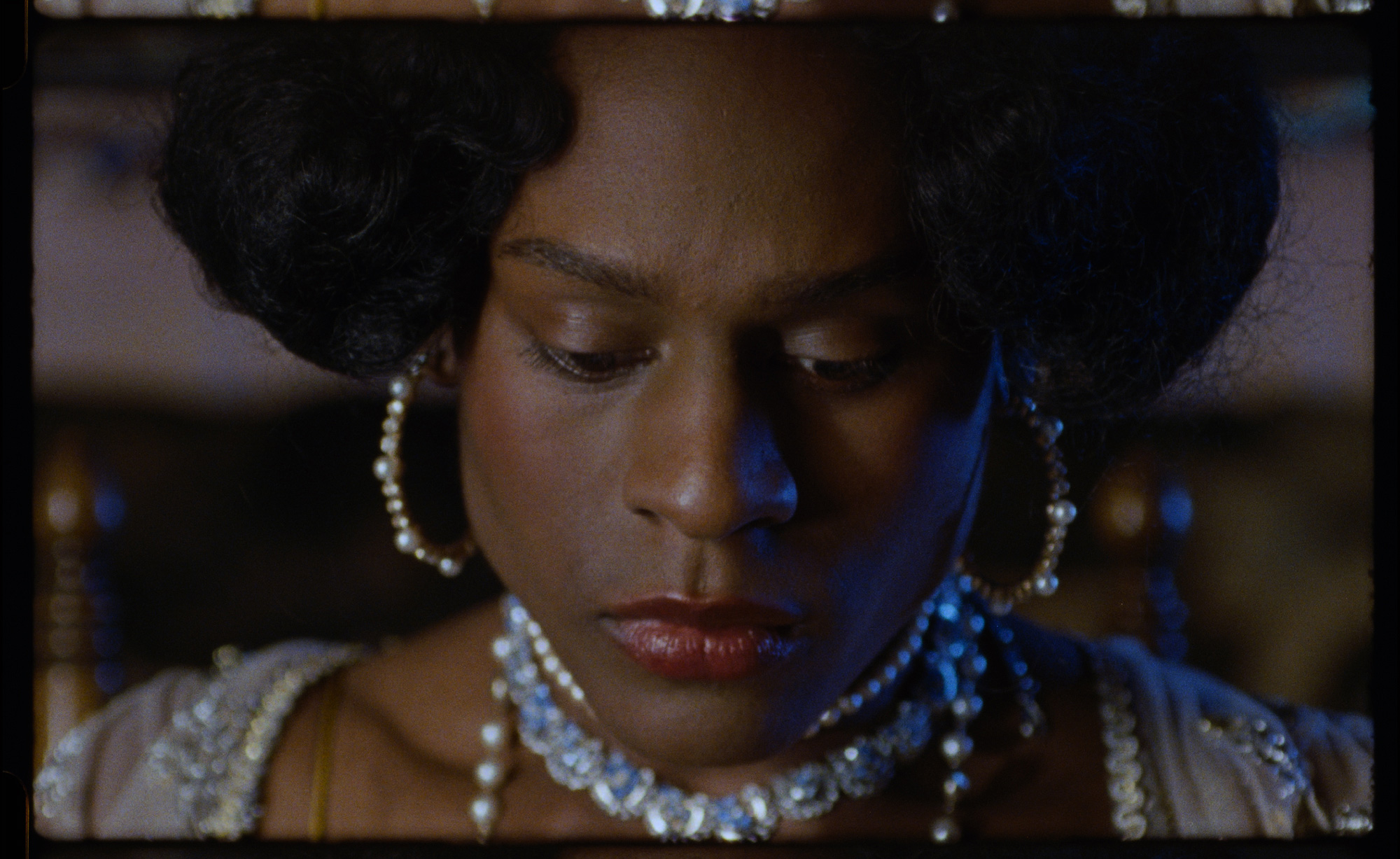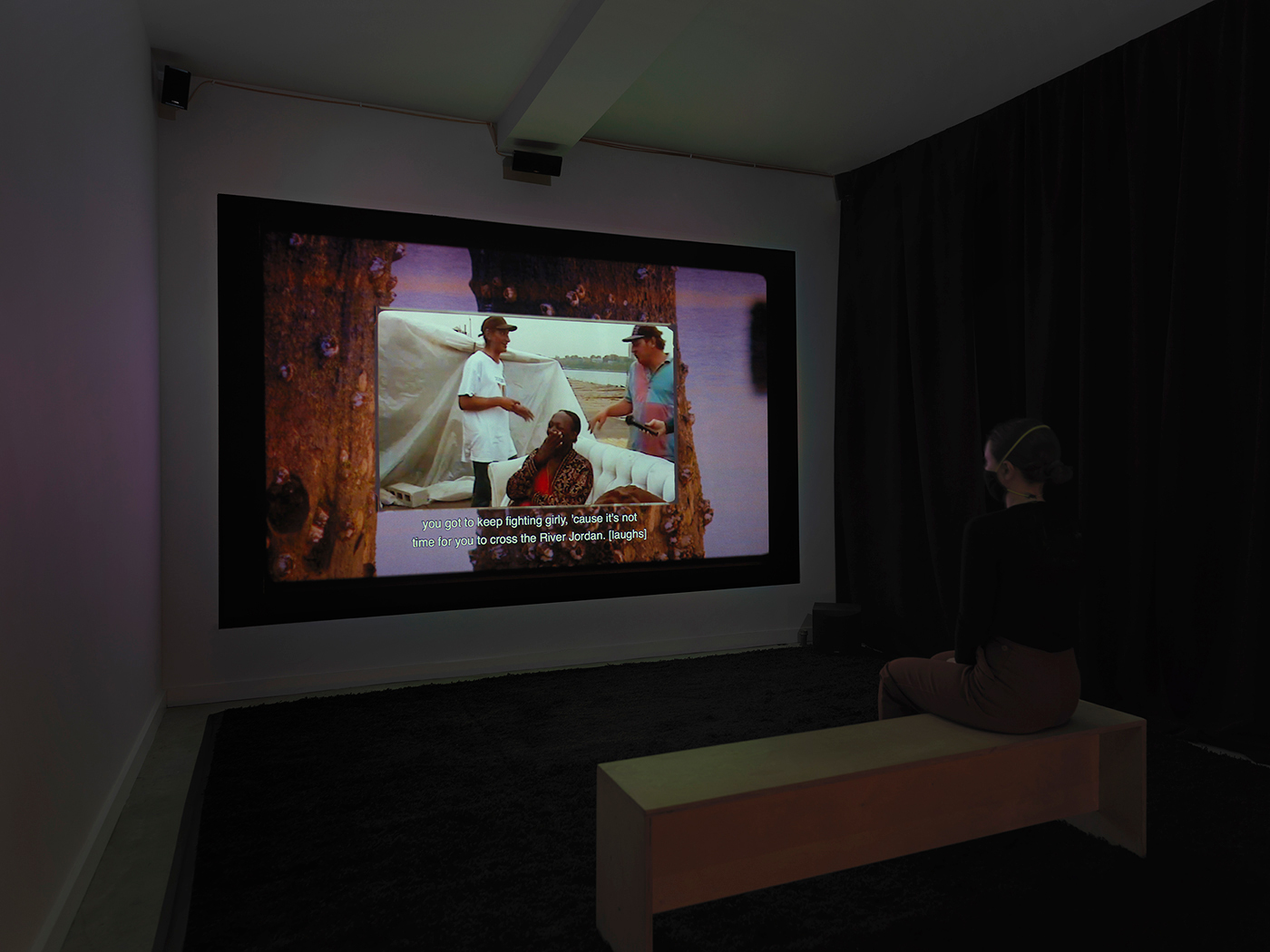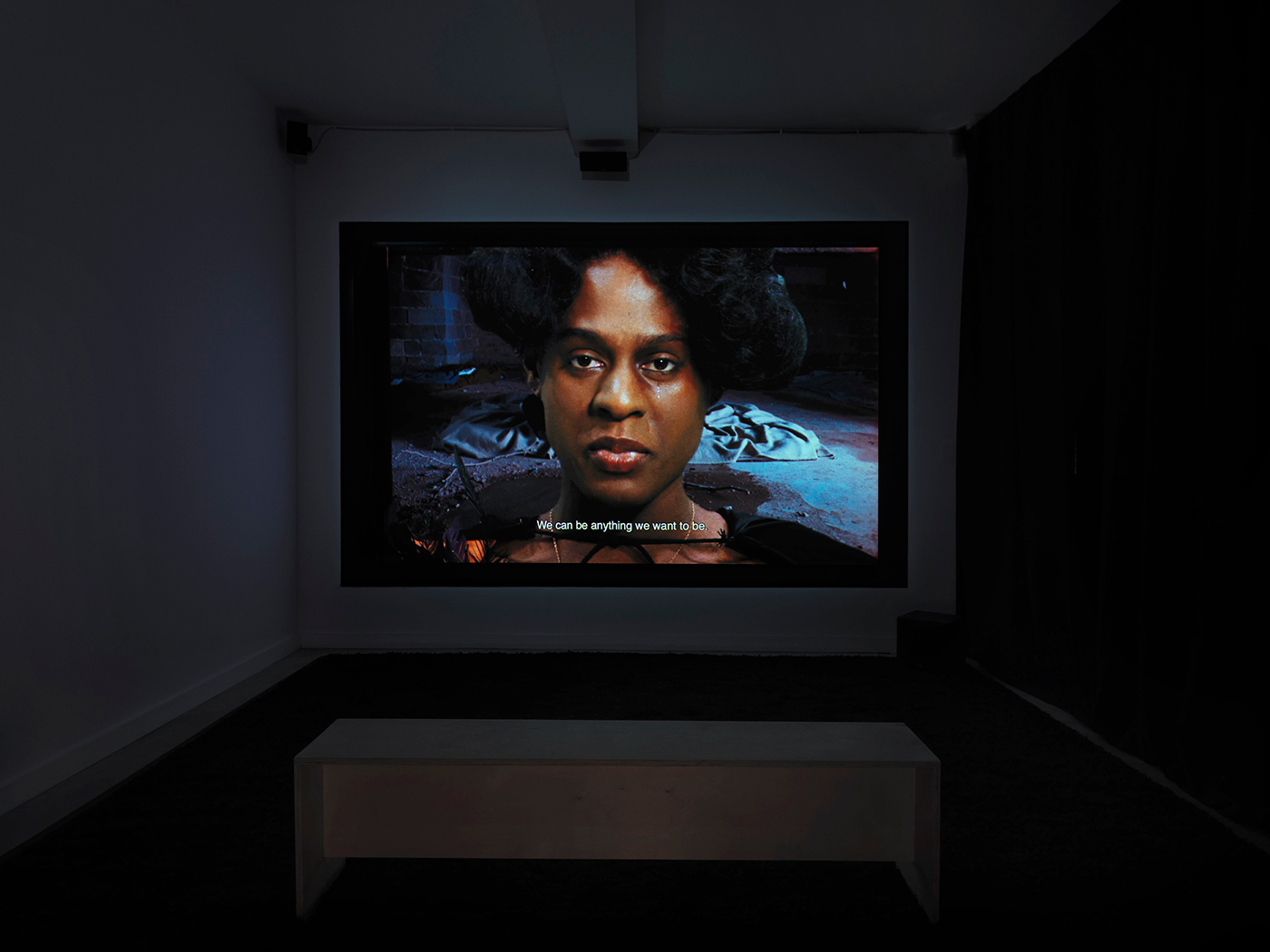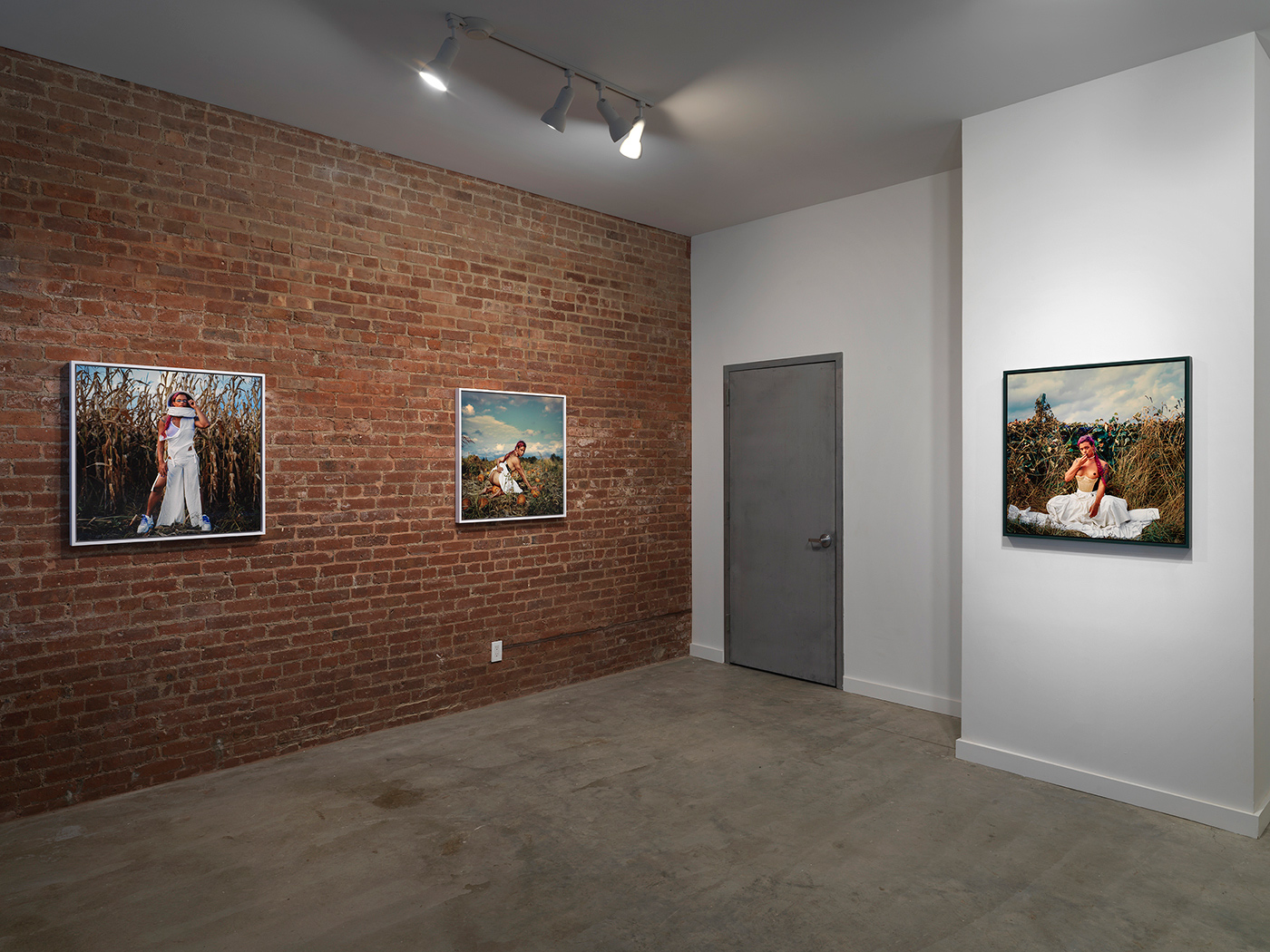 Tiana Reid
Tiana Reid
The artist nurtures a blossoming archive.

Tourmaline, Salacia, 2019. 16mm, sound, 6 minutes 4 seconds. Courtesy the artist and Chaptery NY.
Tourmaline: Pleasure Garden, Chapter NY (pop-up location), 126 Madison Street, New York City, through January 24, 2021
• • •
The title of New York City–based artist Tourmaline’s first solo show, Pleasure Garden, feels like the name of a place that has yet to take complete shape. But it is clearly a place where pleasure lies. Here, pleasure blooms and blossoms. Here, too, is where pleasure is planted, manicured, and groomed. Once you let it in, there is no turning your back on pleasure. It will grow.
Pleasure Garden consists of one recent short 16mm film, Salacia (2019), and a series of newer photographs named after garden-pollinating butterflies (all 2020), pictures that use the film as a jumping-off point for experimental self-portraiture. Tourmaline’s Salacia reimagines a real-life nineteenth-century trans woman named Mary Jones, as if she had lived, in the 1820s and 1830s, in Seneca Village—a historically Black community that was demolished for the establishment of Central Park. Over the course of the film’s six minutes, Salacia follows a steely-eyed Jones (played by Rowin Amone), but the piece, which was produced by Keanu Reeves and recently acquired by the Museum of Modern Art, is not a work of history. Salacia leans into a quiet drama, through thick nineteenth-century drawls and intense cinematic techniques including green screen and slow motion. So much happens in this little art movie, so much leaping and crisscrossing, from day to night, from split-screen to single, from the nineteenth to the twentieth centuries.

Tourmaline: Pleasure Garden, installation view. Pictured: Salacia, 2019. Courtesy the artist and Chaptery NY. Photo: Dario Lasagni.
Like Pleasure Garden, Salacia—a saltwater goddess in Roman mythology—is a nom de guerre. The references are numerous. Activist Sylvia Rivera, who appears midway into the film via found footage, assimilates the Hudson to the River Jordan. At the end, Jones uses water as a looking glass. But “salacia” might also suggest the “saltwater slavery” theorized by historian Stephanie E. Smallwood, who sought to write the experience of the transatlantic slave trade not as an orderly linear narrative, but as “an indeterminate passage” of ceaseless rupture with no known end. When, in a voiceover, Rivera says, “You got to keep fighting girly,” she is also speaking to a limboed past—Tourmaline refuses the container of time in this film, and Jones contains the seed that could germinate new readings of that past. Like Toni Morrison’s Sethe in Beloved, for whom “the future was a matter of keeping the past at bay,” there is sweetness in speculation. But in the final moments, Jones gazes into the screen, chanting “We can be anything we want to be” over and over.

Tourmaline: Pleasure Garden, installation view. Pictured: Salacia, 2019. Courtesy the artist and Chaptery NY. Photo: Dario Lasagni.
Aside from these sparse but sumptuous rallying cries, there is not much dialogue to muddle through in Salacia—it is more dazzling to watch, to listen, to feel. When words don’t cut it, what speaks is a flurry of sounds: rushing wind, the cooing of a mourning dove, the clinking of teacups, bird songs, twinkly music, cricket chirpings, the rustling of sheets outside. Most compellingly, the title Salacia perhaps evokes a general salaciousness, a pleasure principle. Pleasure is pursued as its own open end.

Tourmaline: Pleasure Garden, installation view. Pictured: Salacia, 2019. Courtesy the artist and Chaptery NY. Photo: Dario Lasagni.
Mary Jones is sent to us by an artist bent on play and imagination; Tourmaline weaves fiction into Jones’s story not as a wild thing to do to the archive but as the artist’s obvious starting line. Hostile circumstances congealed Jones into a historic persona. Jones, who was called a “Man Monster” on a Wanted ad and outed by the New York press, was arrested for sex work and pickpocketing, but these charges were perhaps ancillary—her mere existence was enough to trouble the law. In court, Jones said she’d been told she “looked so much better” in women’s clothes—an elaboration that glimpses how her desires went beyond mere survival. In Salacia, she lives in a pleasure garden of her own design.

Tourmaline: Pleasure Garden, installation view. Pictured, left to right: Coral Hairstreak, Sleepy Orange Sulphur, and Morning Cloak, all 2020. Courtesy the artist and Chaptery NY. Photo: Dario Lasagni.
Off the cavernous screening room for Salacia are five plein-air color photographs, all self-portraits. In a way, through her photographs Tourmaline is unpacking the storying of Salacia, drawing on Victorian-era pornography and turning it inside out. But where Salacia slowly forecasts disaster, the photographs of Pleasure Garden, taken together, emote possibility, construct a horizon of the limitlessness, disrupt received narratives about what black trans women are expected to endure. There are entire academic and artistic disciplines about how blackness and gender are co-constitutive (or co-disruptive). Salacia is in conversation with this rich dialogue about how blackness undermines normative articulations of gender: it leads us, for instance, to consider how Hortense Spillers’s 1987 idea of the “ungendered” captive slave might apply to the trans subject.

Tourmaline, Summer Azure, 2020. Dye sublimation print, 29 1/2 × 30 inches. Courtesy the artist and Chaptery NY. Photo: Dario Lasagni.
In her photography, though, Tourmaline is her own valiant subject, appearing mid-air against a prophetic sky in Summer Azure. She is holding a helmet on her head, ready for movement. But it’s unclear if her bare feet are perching or springing, if she’s going up or down. Coral Hairstreak has her in the midst of corn husks, fuchsia-pink hair braided down one side, standing in a deconstructed spacesuit, kept together by loose harnesses, and blue-laced platform sneakers, an obvious nod to Afrofuturism. In Sleepy Orange Sulphur, Swallowtail, and Morning Cloak, she’s wearing—or not wearing—an undercut corset, with an oversized cloak billowing about. Caught up in her own erotics, the artist reclines in Swallowtail, with pearls reminiscent of those Jones wore in Salacia. Morning Cloak is the most arresting: the artist, crouching among green and brown foliage, holds her right hand up to her mouth; she sucks in her cheeks, her torso almost hovering over the ground.

Tourmaline, Morning Cloak, 2020. Dye sublimation print, 29 1/2 × 30 inches. Courtesy the artist and Chaptery NY. Photo: Dario Lasagni.
In all five photographs, Tourmaline stares directly at the camera. Or is it into? But in Coral Hairstreak, small mirrored glasses cover her eyes, and in Summer Azure, a shining glare bouncing off her helmet’s plastic visor partly eclipses her face. Inevitably, behind all the luxuriating accoutrements in the film and the photographs—those fancies that not only make life bearable but worth living at all—the subject is compelled, to some degree, to be blank, to preserve herself as inscrutable and unknown. Likewise, in the film, Tourmaline obscures Jones instead of clarifying her. This inscrutability bars the audience from projecting their small scripts about blackness, transness, femmeness, love, sex work, theft; there is too much blank space in this compact show for any tidy narrative resolution.

Tourmaline, Coral Hairstreak, 2020. Dye sublimation print, 29 1/2 × 30 inches. Courtesy the artist and Chaptery NY. Photo: Dario Lasagni.
Last year, Tourmaline tweeted, “I don’t make short films. I make cinematic edge play films. Leave you wanting more films. This is all you can digest from me right now films!” With a spirit like that, Jones becomes an unfinished script. Tourmaline excavates Jones from the garbage dump we call a historical archive, but by doing a little pruning and decorating, she sidesteps the empty romance of a full recuperative project. If historical fact were our only garden, there would be nothing left to grow. Instead, in her sweeping pursuit of creative liberation, Tourmaline gives us things that flourish.
Tiana Reid is a writer from Toronto. She lives in New York City, where she is a PhD candidate and teacher at Columbia University. She has written for many publications, including Art in America, Bookforum, frieze, the New York Review of Books, the New York Times, the Paris Review, Teen Vogue, and Vulture. She is a former senior editor at the New Inquiry and was a founding editor of Pinko, a print magazine of gay communism.